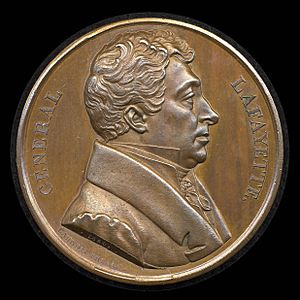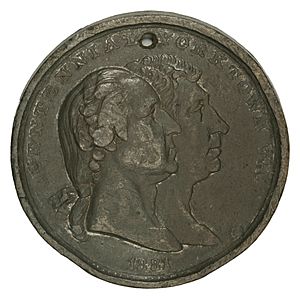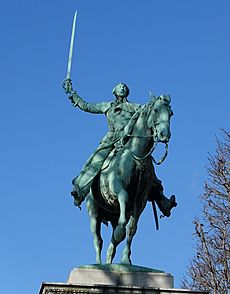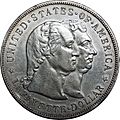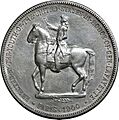Lafayette dollar facts for kids
| United States | |
| Value | 1 United States dollar |
|---|---|
| Mass | 26.73 g (412.5 gr) |
| Diameter | 38.1 mm (1.5 in) |
| Edge | reeded |
| Composition | |
| Silver | 0.77344 troy oz |
| Years of minting | 1899 (a 1900 date appears on the coin) |
| Mintage | 50,026 (less 26 assay coins and 14,000 melted) |
| Mint marks | None. All specimens struck at Philadelphia Mint without mint mark. |
| Obverse | |
 |
|
| Design | Conjoined busts of Washington and Lafayette |
| Designer | Charles E. Barber |
| Design date | 1899 |
| Reverse | |
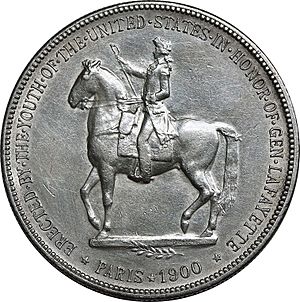 |
|
| Design | Equestrian statue of Lafayette |
| Designer | Charles E. Barber |
| Design date | 1899 |
The Lafayette dollar was a special silver coin made by the United States. It was created for the Paris World's Fair of 1900. This coin shows both Gilbert du Motier, Marquis de Lafayette and George Washington. It was designed by the U.S. Mint's Chief Engraver, Charles E. Barber.
This coin was very unique! It was the only U.S. silver dollar made to celebrate a special event before 1983. It was also the first U.S. coin to show American citizens.
In 1898, some important Americans wanted to build a monument in Paris to honor Lafayette. He was a French hero who helped America in the American Revolutionary War. Ferdinand Peck, a businessman from Chicago, was chosen by President William McKinley to lead the American efforts for the World's Fair. Peck decided to make the monument part of the fair's plans. He created the Lafayette Memorial Commission to raise money for it. One way to raise money was to create a special one-dollar coin. Congress approved this idea on March 3, 1899.
The front (obverse) of the coin shows the heads of Washington and Lafayette together. Barber said he based Washington's image on a sculpture by Jean-Antoine Houdon. He based Lafayette's image on an 1824 medal by François-Augustin Caunois. For the back (reverse), he used an early drawing of the planned monument. This monument was designed by Paul Wayland Bartlett, whose name is on the statue's base on the coin. Not all the coins sold, and 14,000 of them were later melted down by the U.S. Treasury. Today, a Lafayette dollar can be worth hundreds or even thousands of dollars, depending on its condition.
Contents
Who Was Lafayette?
Gilbert du Motier de La Fayette was born in France on September 6, 1757. He came from a rich, noble family. When he was very young, his father died in a battle. This made Lafayette a wealthy nobleman at just two years old. He got married in 1774.
In 1775, Lafayette was on military duty. He heard about the American Revolution happening in the Thirteen Colonies. The young officer quickly believed that the American fight for freedom was a good cause. He learned that the American Congress didn't have much money. So, Lafayette bought his own ship and sailed to America in 1777.
At first, Congress wasn't very welcoming. Many foreign officers wanted to join the Continental Army. General George Washington even asked that no more be hired. But Lafayette offered to fight without pay. He eventually succeeded because Benjamin Franklin, an American envoy in France, wrote a letter. Franklin said Lafayette's family was rich and important. He urged Congress to help Lafayette and keep him safe.
Congress agreed in July 1777 and made Lafayette a major general. They sent him to meet Washington. Even though Washington was 25 years older, they became very close friends. Lafayette wanted to be in the middle of battles, which was different from Franklin's wish to keep him safe. He was even wounded at the Battle of Brandywine in September 1777.
France soon joined the war to help America. This help was very important for America's victory. Lafayette helped lead the important Yorktown campaign. This led to the surrender of General Lord Cornwallis and his entire army. This battle sealed America's victory in the war.
May this immense Temple of Freedom ever stand, a lesson to oppressors, an example to the oppressed, a sanctuary for the rights of mankind! And may these happy United States attain that complete splendor and prosperity which will illustrate the blessings of their Government, and for ages to come rejoice the departed souls of its founders.
After 1781, Lafayette went back to France. He was a hero in both countries. He visited the United States again in 1784. This was his last visit for 40 years. In France, he became involved in politics. He supported the idea of a king who followed a constitution. After the French Revolution, he was given important jobs. But he was captured by the Austrians in 1792 and stayed in prison for five years.
After Napoleon helped him get released, Lafayette stayed on his family's land. He stayed away from politics while Napoleon was in charge. After the king returned to power in 1815, Lafayette again joined politics. He served in the Chamber of Deputies.
In 1824, the American Congress voted to invite Lafayette back to the U.S. as a national guest. Lafayette and his son, George Washington Lafayette, arrived in New York City. They were met with huge celebrations. For the next year and a half, Lafayette visited all 24 states. He received many honors and gifts, including land in Florida. Lafayette returned to France in 1825 and died in 1834. He is one of only eight people to be made an honorary citizen of the United States. According to author Arnie Slabaugh, Lafayette helped create a strong friendship between the two nations that continues today.
How the Coin Idea Started
In March 1898, a plan was introduced in Congress. It was to create a group to build a monument to Lafayette in Paris. This monument would be from the United States. The plan passed the Senate. Hearings were held in the House of Representatives. Ferdinand Peck, a Chicago businessman, spoke in favor of the plan. However, the House didn't vote on it because of the Spanish–American War.
Later in 1898, President William McKinley chose Peck to be the U.S. Commissioner-General for the 1900 Exposition Universelle. This was a World's Fair in Paris, France. Peck brought back the idea of the Lafayette monument. He made it part of America's plans for the fair. He created the Lafayette Memorial Commission to manage the monument project. The commission wanted the monument to be revealed on July 4, 1900. This was both Independence Day and the U.S. Day at the fair. On September 1, 1898, Peck appointed many important Americans to the commission. These included Senator William B. Allison and Secretary of State William R. Day.
Raising money for the monument was a big part of the commission's work. They wanted American schools and children to help. October 19, 1898, was declared the first "Lafayette Day." This was the 117th anniversary of Cornwallis's surrender at Yorktown. Many governors and education leaders made this proclamation. President McKinley praised the plan in a letter. Special ceremonies were held in many schools. Students were asked to donate cents to honor Lafayette. Over $45,000 was collected from schools. On the next Lafayette Day, schools received special receipts signed by the commission's treasurer, Charles G. Dawes.
Another idea for paying for the statue was a special coin. In early 1899, the commission asked Congress for $50,000. They wanted this money in the form of 100,000 commemorative half dollars. They planned to sell these coins to the public for more than their face value. This method had been used before for the 1893 World's Columbian Exposition. Instead, Congress passed a bill on March 3, 1899. President McKinley signed it. This bill gave the commission 50,000 silver one-dollar coins. The silver for these coins was bought on the open market. The cost of the silver was limited to $25,000. The U.S. Treasury bought over 38,000 troy ounces of silver for about $23,000. The Mint Director and the Secretary of the Treasury would approve the coin designs.
Designing the Coin
After the bill passed, the Mint's Chief Engraver, Charles E. Barber, took charge of the project. He wanted to avoid problems that had happened with earlier commemorative coins. On March 24, 1899, Mint Director George E. Roberts wrote that the Lafayette Memorial Commission wanted the new monument on one side of the coin. Barber asked for a sketch of the monument the next day.
By April 12, 1899, Barber had a first sketch of the monument. It was an equestrian (horseback) statue by Paul Wayland Bartlett. Barber drew other designs too. One showed Lafayette's 1784 prayer for the U.S. Another showed Lafayette standing, without a horse. Barber's ideas for the coin included an equestrian statue on one side. On the other side, he suggested showing the heads of Lafayette and Washington together. Director Roberts quickly approved the sketch of the two heads. He shared this information with a coin magazine, which printed it in April 1899.
On May 23, 1899, Barber wrote that he planned to base Washington's image on a famous 1785 sculpture by Jean-Antoine Houdon. He also used an early medal from 1786. Lafayette's image was to be based on an 1824 medal by François-Augustin Caunois.
Peck and other commission members were not happy with the designs. They suggested their own ideas. Barber didn't like these ideas. He said that the heads of Washington and Lafayette should be shown with "grandeur and dignity." He felt that just showing their faces "peeping out of a half moon" wouldn't work. At Roberts's direction, Barber met with Peck in New York. After the meeting, Barber reported that Peck now understood the limited space on a silver dollar. He also realized that the monument's design had to be approved by a committee in Paris.
On June 20, 1899, Barber submitted the final designs for the coin. Director Roberts approved them on July 1. But there was still a disagreement about the date. The commission wanted the coins dated 1900, but they wanted to sell them in 1899. Secretary of the Treasury Lyman Gage insisted that the coins must show the year they were made. They reached a compromise: the coins were made in December 1899. They were not given out until January 1900. The coins have "Paris 1900" written on them.
Coin Design Details
The front (obverse) of the Lafayette dollar shows the heads of Washington and Lafayette joined together. Experts believe that the design was inspired by the 1881 Yorktown Centennial medal. This medal was created by Peter L. Krider, a Philadelphia engraver. The words "United States of America" and "Lafayette Dollar" are at the top and bottom of the front of the coin.
The back (reverse) of the coin is based on an early sketch of the Lafayette statue by Bartlett. It shows Lafayette on horseback, riding to the left. Barber's own initials are not on the coin. However, the name "Bartlett" is carved on the base of the statue. A palm branch is also shown below the statue. The words on the back say: "Erected by the youth of the United States in honor of Gen Lafayette/Paris 1900." This honors the schoolchildren who helped raise money. Even though the coins were made in 1899, they show "Paris 1900." This was meant to be the year of the World's Fair and when the statue would be put up.
On the back, Lafayette holds a sword pointing upwards. Bartlett said his statue showed Lafayette "offering his sword and services to the American colonists in the cause of liberty." It was a symbol of France's support for America's fight for freedom. Some experts note that Lafayette's pose on the coin looks like he is in a victory parade. His sword is in its sheath, like a flag, not ready for battle.
Many people have criticized Barber's design for the Lafayette dollar. Some say Washington's head looks "lifeless." Others say the details are not as good as on other medals. Art historians have also said that the coin has too much lettering. They felt that "Paris 1900" or "From the Youth of the United States" would have been enough.
Making and Selling the Coins
All Lafayette dollars were made at the Philadelphia Mint on December 14, 1899. This was exactly 100 years after George Washington died. The Philadelphia Public Ledger newspaper reported on the special ceremony.
Several Mint officials, members of the Lafayette Memorial Commission, and reporters were there. A coining press operator, Miss Gleary, took out the first Lafayette dollar made. She gave it to Mint Superintendent Henry Boyer. Chief Engraver Charles E. Barber then checked it. It was shown to Robert J. Thompson, the commission's secretary. Then it was given to Mint Director George E. Roberts. The coin was put in a special case and taken to Washington, D.C. Roberts gave it to President William McKinley. This first coin was then sent in a fancy $1,000 presentation case to the president of France.
Once the ceremony ended, the Mint continued making Lafayette dollars. They used an older press that could make 4,800 coins per hour. A total of 50,026 coins were made. This included 26 coins set aside for testing by the United States Assay Commission in 1900.
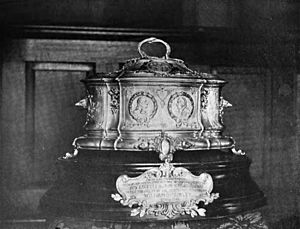
The first Columbian half dollar had sold for $10,000. An offer of $5,000 was made for the first Lafayette dollar, but it was turned down. This coin was meant for the French president. Thompson, acting as a special U.S. commissioner, took the casket to France. The ceremony was supposed to be on Washington's Birthday (February 22, 1900). But it happened on March 3, when Thompson gave the coin and casket to French President Émile Loubet. These items are now in the Louvre museum in Paris.
The commission faced some money problems. In January 1900, a sculptor named Charles Henry Niehaus wondered why the fundraising goal was $150,000. He said no equestrian statue had ever cost more than half that amount. The commission was also sued by an architect who wanted fees for designing the statue's base. They settled out of court.
The commission was late in giving the final order for the statue to Bartlett. Because of this, the final bronze statue couldn't be ready in time for July 4, 1900. Instead, a full-sized plaster model was made. This model was dedicated in Paris on July 4, 1900. Later, Bartlett made changes to the design. His bronze statue, put up in 1908, looks different from the one on the coin. For example, Lafayette's hat was removed, and his raised arm and sword position changed. The statue stood in the Place du Carrousel for almost 80 years. In the 1980s, it was moved during work on the Louvre museum. It now stands on Cours-la-Reine in Paris, along the River Seine.
After the coins were made, the commission started selling them for $2 each. Sales were handled by a bank in Chicago. Only a small number were sold to coin collectors. Sales continued for several years. The price of the coins dropped on the secondary market. By 1903, you could buy them for $1.10. Thousands of coins may have been used as regular money. By 1920, the market price went above the original $2. Prices kept rising steadily. By 1975, a coin could be worth $650.
Fourteen thousand coins were returned to the Treasury. They were kept in bags. This happened because sales were poor in Paris; only 1,800 coins sold there. About 10,000 coins were sent back to the United States. They were held for many years. In 1945, a coin dealer named Aubrey Beebe asked about them. He was told the coins had recently been melted down.
The Lafayette dollar was the first American coin to show a U.S. citizen. After this coin, the Mint did not make another commemorative silver dollar until the 1983-S Los Angeles Olympics dollar.
Collecting Lafayette Dollars
In 1925, a coin expert named George H. Clapp found a Lafayette dollar that was slightly different from what was described. He studied it for ten years and found two more varieties (small differences). These differences exist because multiple dies (tools used to make coins) were used. The dies were not exactly the same. In 2012, another expert, Swiatek, found a fifth variety. He looked at hundreds of Lafayette dollars. He found that two varieties made up over 90% of the coins. The other varieties are much rarer. This suggests that the coins were made on at least two machines. The rarer varieties might have been made when new dies were put in as the old ones wore out. The differences are very small. For example, the "M" in "America" might be slightly raised or even with the "A" next to it. Because the differences are minor, collectors usually don't pay extra for the rarer varieties.
R.S. Yeoman's A Guide Book of United States Coins (2018 edition) lists the Lafayette dollar. A coin in Almost Uncirculated (AU-50) condition is worth about $485. A coin in nearly perfect (MS-66) condition can be worth up to $15,000. One coin in MS-67 condition sold for $73,438 in 2015. Most Lafayette dollars have small marks from hitting other coins. This is because they were dropped into a bin after being made. No effort was made to protect them for collectors. A well-made coin will show a clear line separating Lafayette's boot from his uniform. Details of his clothing will also be clear. The highest points on the coin, where wear would show first, are Washington's cheekbone on the front and Lafayette's face on the back.
Sometimes, fake Lafayette dollars are made. Also, some genuine coins are polished to make them look shinier. This damages their surfaces and their original look.
Images for kids
See also
 In Spanish: Dólar Lafayette para niños
In Spanish: Dólar Lafayette para niños



